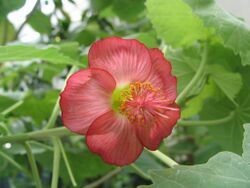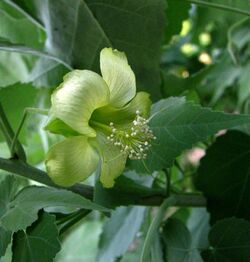Biology:Abutilon menziesii
| Abutilon menziesii | |
|---|---|

| |
| Scientific classification | |
| Kingdom: | Plantae |
| Clade: | Tracheophytes |
| Clade: | Angiosperms |
| Clade: | Eudicots |
| Clade: | Rosids |
| Order: | Malvales |
| Family: | Malvaceae |
| Genus: | Abutilon |
| Species: | A. menziesii
|
| Binomial name | |
| Abutilon menziesii Seem.
| |
Abutilon menziesii, known as Koʻoloaʻula in Hawaiian, is an endangered species of flowering shrub in the family Malvaceae, that is endemic to Hawaii.
Description
It is a sprawling shrub that can reach up to 10 feet in height. The leaves, which range from an inch in width to about five inches, vary in their shapes. They have a velvety feel to them. The small hibiscus-shaped flowers generally hang downward. Though charming up close, the flowers can be hidden by the much larger leaves and not often visible at a distance. Although the Hawaiian name ʻula refers to the more commonly seen red color, koʻoloa ʻula flowers are known in a range of colors: pink, pink and white, pale red, maroon, deep purplish-red (wine), salmon, and blond or butter. The center or staminal column is yellowish.[2][3]
The plant is typically propagated by seeds. The seed capsules are pale brown, fuzzy, and about 3/8" long, typically containing 18-24 small, dark brown seeds.[4]
It inhabits dry forests on the islands of Lānaʻi, Maui, Oʻahu and Hawaiʻi.[4] It is classified as critically endangered by the IUCN Red List; only about 450–500 plants remain in fewer than ten naturally occurring populations throughout the islands.[3] The rarity of this plant can be attributed to the alteration of its habitat for agricultural and urban development, overgrazing by livestock and feral animals, and competition from invasive weeds. A conservation plan is being implemented by federal and state agencies to protect remaining habitat, establish new populations, and conserve genetic material in seed banks and botanical gardens.[5]
References
- ↑ Bruegmann, M.; Caraway, V.L. (2003). "Abutilon menziesii". IUCN Red List of Threatened Species 2003: e.T44060A10847191. doi:10.2305/IUCN.UK.2003.RLTS.T44060A10847191.en. https://www.iucnredlist.org/species/44060/10847191. Retrieved 12 November 2021.
- ↑ "Abutilon menziesii". http://nativeplants.hawaii.edu/plant/view/abutilon_menziesii.
- ↑ 3.0 3.1 "The Critically Endangered Abutilon Menziesii (Ko'oloa'ula) Plant: Endemic to Hawaii and Declining". https://owlcation.com/stem/The-Stunning-Flowers-of-the-Critically-Endangered-Abutilon-Menziesii-Plant.
- ↑ 4.0 4.1 "Abutilon menziesii". University of Hawaiʻi at Mānoa. https://www.ctahr.hawaii.edu/hawnprop/plants/abu-menz.htm.
- ↑ "Habitat Conservation Plan for Abutilon mensiesii". Hawaii Department of Land and Natural Resources. http://dlnr.hawaii.gov/wildlife/hcp/approved-hcps/.
External links
- United States Botanic Garden
- Abutilon menziesii information from the Hawaiian Ecosystems at Risk project (HEAR)
- Barboza, Rick (2006-08-04). "Flowers make shrub stand out". Honolulu Star-Bulletin 11 (216). http://archives.starbulletin.com/2006/08/04/features/garden.html.
- "Abutilon menziesii". Meet the Plants. National Tropical Botanical Garden. https://ntbg.org/database/plants/detail/abutilon-menziesii.
Wikidata ☰ Q599595 entry
 |



